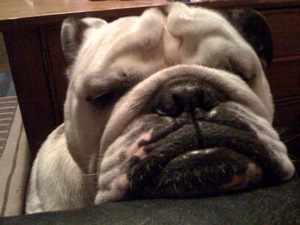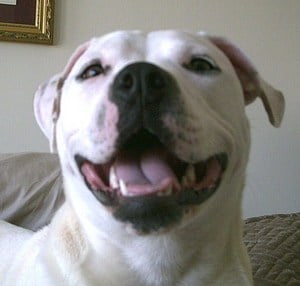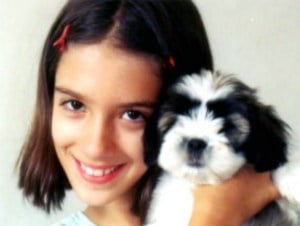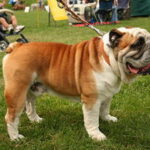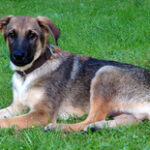English Bulldogs, like many pedigree breeds, often suffer from allergies. My 4.5-year-old bulldog, Ribeye, is no exception. We’ve received advice from veterinarians, allergists, breeders, and other bulldog owners. Here’s a round-up of five common allergy symptoms, as well as what worked and didn’t work for Ribeye.
Symptom: Excessive Mucus
At about 11 months old, Ribeye began vomiting a couple times a week, with about a half cup of mucus at a time. Of all the dog messes I’ve had to clean up, this is the most nauseating. After joining several bulldog owner groups on Yahoo, I found that grain allergies are quite common in this breed. A quick trip to a local pet food store set us up with samples of several types of single grain foods. I’ve been told by breeders and pet store owners that corn is the most common grain allergy, but it turns out that Ribeye the bulldog is allergic to wheat. He was flem free within two days of putting him on a wheat free diet.
Tips: if you’re hoping for free dogfood samples, do not go to a chain store; go to a proprietor owned shop. Be sure to check the ingredients on your dog treats as well, and start carrying a treat bag so that you’re covered for situations where someone wants to give your dog a cookie.
At 3 years old at 60lbs, Ribeye’s excessive mucus production returned. I tried eliminating all grains one a time, and he is now eating a duck and potato diet. The mucus is still present, although to a lesser level, with maybe one mucus vomit incident every other week. When the incidents increase in frequency, I’ve found that giving him 2 Benadryl at night helps him to be less congested and sleep better. Generic Benadryl, diphenhydramine hydrochloride, works just fine, and I now keep a 100 tablet bottle in the house just for Ribeye. It does leave him groggy the next morning. Online bulldog groups have suggested lemon juice in his water dish, to cut the mucus, but it does not seem to help him. I do keep lemon juice on hand in case his throat should ever fill with foam or mucus, as the acid is known to cut through this.
Symptom: Flakey Skin, Fur Falling Out
At 2 years old, Ribeye began losing small patches of fur, with flakey skin showing up underneath. His coat had become dull and coarse. It didn’t seem to bother him much, but he didn’t look well. Since there were no other symptoms, our vet was not too concerned. Some meet ups with other bulldog owners led me to try another shift in Ribeye’s diet. He had been eating Iam’s Lamb and Rice dog food very successfully, meaning we were having no more mucus vomit incidents. We switched to Nutro Lamb and Rice and within 2 weeks he had a full coat of fur again. Nutro touts that their brand covers more essential vitamins and minerals that dogs need for a healthy coat. In addition to having a full coat, Ribeye’s fur had more sheen and was softer. He also seemed perkier, so my instinct is that his former diet was missing something necessary for him.
Symptom: Hives
At about 2.5 years old, during the summer months, Ribeye the bulldog turned up with itchy, crusty, scab-like patches on his belly. A quick trip to our vet came down with the diagnosis of infected hives. I was horrified; feeling like this meant that I was a lame dog owner. The vet quickly explained that hives are very itchy, and bulldogs carry so much bacteria on their claws that any scratching will almost always result in infected lesions within 24 hours. He gave us antibiotics and advice for future bouts of hives. Bulldogs tolerate generic Benadryl (diphenhydramine hydrochloride) very well, and can consume up to 25mg per 25lbs of bulldog. Our vet opined that the allergy was most likely to grass pollen, since allergy testing in our area was turning up many dogs with an allergy to local grass strains. Ribeye seems to break out in hives predominantly in the summer months. One Benadryl stops the hives in their tracks.
Tips: The beginning stage of Ribeye’s hives look like pink lumps smaller than a bug bite. The area surrounding the bumps also appears pink and irritated. I give him one 25mg generic Benadryl pill and monitor him over the next 2-3 hours; I’ve never had to give him more than 1 pill at a time, but I have given him 2 pills over the course of 24 hours.
At 4 years old, Ribeye began getting hives at other times of year, and neither I nor his regular vet could guess what allergen could be bothering him. I took him to a veterinary allergist, who ran panels to find that he is allergic to sage brush, grass and tree pollen. Allergy shots to turn on his immune system were frustrating. These involved giving Ribeye a lose-dose shot of the offending allergens every few days. He burst out in hives at the end of the first month, which is a sign that the shot levels were increasing too fast for him. The allergist let us know that he needed a break, and that we could try again when he seemed allergy free. The good news is that she recommended another option in the meantime: Atopica. Since being on Atopica, he has had no hives, even through yet another heavy allergy summer in Portland, OR. The bad news is that Atopica costs about $3 per day, and I have not found any cheaper versions or outlets for it. He has had mucus issues, so we have not tried the allergy shots in the last 6 months.
Symptom: Swollen Foot Pads
At 3.5 years old, the pads on Ribeye’s front left foot became swollen. Our vet diagnosed this as an immune system reaction to allergens. It was the beginning of another heavy allergy summer across all dog breeds in our area. Ribeye had a cyst surgically removed from between his pads, and spent the summer with a bootie on his foot to protect it. Since then, his feet have occasionally become irritated. We now limit the green grass dog park visits in early summer, as that timing corresponds with his foot issues. During early summer months, I wipe down his pads with Malaseb, which is a non-irritating antifungal and antimicrobial solution. One 25mg generic Benadryl also tamps down his reactions.
Symptom: Goop in Skin Folds
At 4 years old, my bulldog Ribeye’s skin folds above his nose and at the base of his tail began to exude an unpleasant odor accompanied by a whitish goop. This turns out to be a dog version of a yeast infection, which is a common reaction to allergens. Our dog allergist has put Ribeye on an ongoing course of Ketoconazole, which helps keep his immune system boosted up to resist yeast overgrowth. It’s working well.
Tip: I check your Ribeye’s wrinkles daily, particularly in the summer, for yeast growth. A quick wipe with Malaseb can stop yeast growth that has not become chronic. If the area becomes inflamed, and does not respond within a day of treating with Malaseb, it’s time for the Ketoconazole.
Building a network of breeders, veterinarians, and other bulldog owners has proved invaluable in dealing with Ribeye’s allergies. It has cut down on the vet visits, increased his quality of life, and made our summer fun time more accessible!
